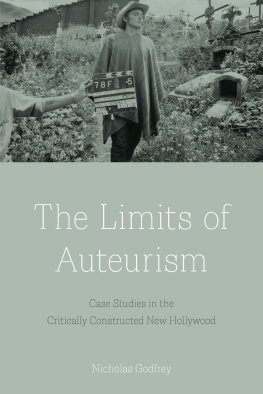Unless otherwise noted, box-office figures refer to gross earnings for the United States and Canada, in US dollars. Historical figures are not adjusted for inflation.
Open Roads
Every age need not be a renaissance; it is only necessary for our own to be one. To that end, critics and audiences create their own masterpieces and their own masters.... We are not, as yet, living in a renaissance.
Stefan Kanfer, Film 69/70, 1970
In recent years the period of film history sometimes known as the New Hollywood has become an increasingly visible area of inquiry. Nick Heffernan neatly summarizes the typical conception of the New Hollywood era as a brief flowering of politically and culturally radical film-making that blossomed with the decline of the traditional movie mass audience in the mid-1960s and withered with the arrival of the big-budget blockbuster in the mid-1970s. Amid growing recognition of the financial power of the youth audience, major motion picture companies began investing in lower-budget, generically unconventional films, and acquiring independently produced titles for distribution. At the center of this narrative is the figure of the untried director, turned loose with studio backing and newfound creative freedom, emboldened by the collapse of the Motion Picture Production Code in the late 1960s.
Under this model, the New Hollywood begins with the films Bonnie and Clyde (dir. Arthur Penn, Warner Bros.-Seven Arts, 1967) and The Graduate (dir. Mike Nichols, Embassy Pictures, 1967) and is closed off with Star Wars (dir. George Lucas, Twentieth Century Fox, 1977) and the associated rise of the blockbuster.
To date, most historical approaches to the films of this period have focused on auteurist accounts of individual directorial careers or attempted to convey broad, totalizing industrial histories. What is yet to emerge is an integrated formal/historical account of the films of the period that identifies the characteristics that distinguish New Hollywood films from the Classical Hollywood cinema that preceded them. Questions remain about the extent to which production conditions unique to the period shaped the aesthetic outcomes that now define retrospective categorizations of this body of films. There is also a dearth of analysis of the critical and discursive environment surrounding theatrical exhibition and the extent to which these commentaries influenced subsequent production trends. To that end, this book undertakes a formal analysis of a sample of key films, linking production practices with aesthetic outcomes and secondary materials associated with distribution and exhibition, while acknowledging the films essential status as historically and industrially determined cultural artifacts.
One of my central aims is to demonstrate the tightly bound links between industrial production and critical and audience reception. While box-office success is the dominant factor in determining the persistence of a film cycle, the potential for commercial impact is often determined, limited, foreclosed, or at least guided by critical reception. Furthermore, this initial period of critical reception plays an important role in determining whether or not a film may achieve canonical longevity beyond its commercial theatrical release. I plan to investigate the role that mainstream film critics played in shaping the film canon that would come to be known as the New Hollywood and the way that this canon has continued to shift over the course of the ensuing decades. My intention is to clarify aspects of the constitution and historical origins of the New Hollywood, the question of what might be considered a typical New Hollywood film, and the extent to which the parameters of such typicality are critically determined. In counterpoint to this notion of typicality, this book also explores the constraints of Hollywoods capacity to be truly experimental in this period of purported creative freedom, as well as the critics ability to be the apparatus of those constraints.
To investigate the formation of the New Hollywood as we now know it, I explore a number of case studies that occupy various positions with respect to the conventional canon. The scope of this study permits the potential inclusion (or partial inclusion) of many movies that have not been considered in relation to New Hollywood in the past. The first of these case studies traces the cycle of road movies that followed in the wake of one of the key New Hollywood films, Easy Rider (dir. Dennis Hopper, Columbia Pictures, 1969). Unprecedented in both its commercial success and cultural influence, Easy Rider transcended its exploitation origins, becoming the kind of inspiration point that Richard Nowell
This situation is not without precedent. The Paramount Decree of 1948 spelled the end of studio vertical integration, requiring the Hollywood major motion picture companies to divest themselves of their exhibition chains. As a result, throughout the 1950s independent distribution companies had a newfound freedom to deal directly with exhibitors. Major distributors increasingly began acquiring independent productions, as B-film production fell out of favor at the studios. At the same time, producers such as Sam Katzman, Samuel Z. Arkoff, and Roger Corman began successfully pitching their low-budget exploitation titles to the burgeoning US teenage audience, which was gaining economic and cultural cachet and increasing visibility throughout the 1950s amid economic prosperity, burgeoning suburbanization, and the rise of car culture. In particular, AIPs mid-1960s biker exploitation cycle borrowed the anarchic sensibility and biker iconography of












